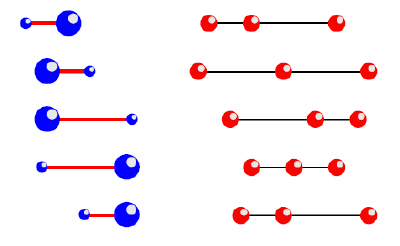Micro Robot Swimmer
"There is vision in nanotechnology of tiny autonomous robots going from one place to another in the human body and fixing things," says Joseph Avron of Technion-Israel Institute of Technology in Haifa. "One major challenge is to figure out how to do this if you are very small - the modes of locomotion that are efficient when you are big will perform poorly if you are small."
The new swimmer, known as "pushmepullyou", consists of two spherical elastic bladders that exchange volumes of material with each other during each swimming stroke. Avron and two colleagues - Oded Kenneth and David Oaknin - predict that their robot will move more efficiently than bacteria and other biological organisms that move by beating a flagellum. Moreover, the pushmepullyou travels faster than other artificial swimmers, like three-linked spheres, because it swims a larger distance with every stroke

Five snapshots of the pushmepullyou swimming stroke (left) and the corresponding strokes of the three linked spheres (right). Both figures are schematic. After a full cycle, the swimmers resume their original shape but are displaced to the right. Pushmepullyou is both more intuitive and more efficient than the three linked spheres. See the movie
The team is now studying nanoscale-sized robots that could swim inside channels in the body - such as inside the spine, heart or lungs - and take images or deliver drugs. "We are also studying swimmers that are so small that quantum mechanics effects become relevant," says Avron
nanotechweb.org
New Journal of Physics source
The new swimmer, known as "pushmepullyou", consists of two spherical elastic bladders that exchange volumes of material with each other during each swimming stroke. Avron and two colleagues - Oded Kenneth and David Oaknin - predict that their robot will move more efficiently than bacteria and other biological organisms that move by beating a flagellum. Moreover, the pushmepullyou travels faster than other artificial swimmers, like three-linked spheres, because it swims a larger distance with every stroke

Five snapshots of the pushmepullyou swimming stroke (left) and the corresponding strokes of the three linked spheres (right). Both figures are schematic. After a full cycle, the swimmers resume their original shape but are displaced to the right. Pushmepullyou is both more intuitive and more efficient than the three linked spheres. See the movie
The team is now studying nanoscale-sized robots that could swim inside channels in the body - such as inside the spine, heart or lungs - and take images or deliver drugs. "We are also studying swimmers that are so small that quantum mechanics effects become relevant," says Avron
nanotechweb.org
New Journal of Physics source

0 Comments:
Post a Comment
Subscribe to Post Comments [Atom]
<< Home